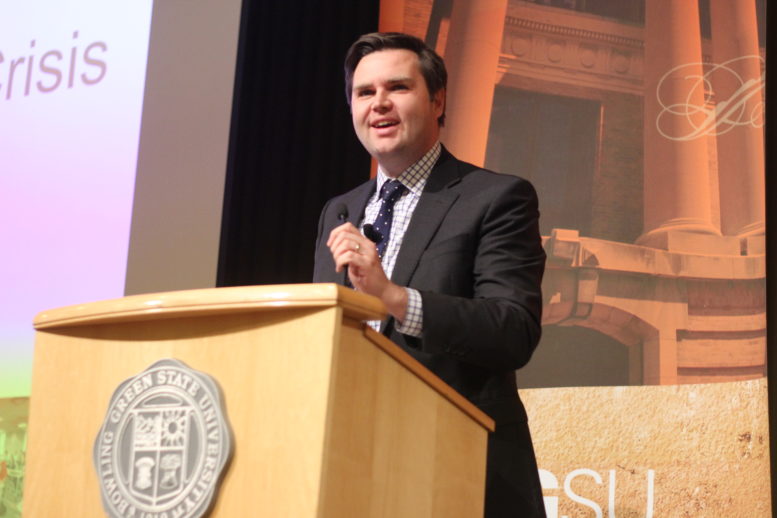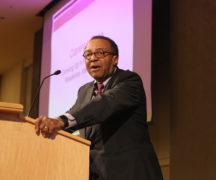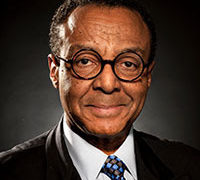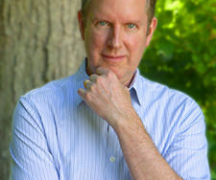By DAVID DUPONT
BG Independent News
The great stabilizing influence in J.D. Vance’s life was his grandmother, Mamaw. The best-selling author of “Hillbilly Elegy” told an audience at Bowling Green State University Wednesday that she always seemed to know what he needed.
When she could barely afford her prescriptions, she still made sure he had the calculator he needed for high school math.
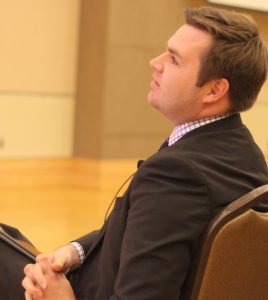
J.D. Vance listens to President Mary Ellen Mazey introduce him.
Mamaw knew he needed “a little discipline and firm hand to not succumb to bad influences” as so many others in his family and community already had. When he started hanging out with an adolescent who was just getting into the drugs, she told Vance if he kept hanging out with him, she would run the kid over with her car.
Her model helped him as he enlisted in the Marine Corps, served in Iraq, got through Ohio State in two years and landed at Yale law school.
Vance visited campus last night as the summation of the Commons Read program. His memoir “Hillbilly Elegy” had been selected.
In introducing Vance, President Mary Ellen Mazey spoke about how the book reflected the hard work, sense of place, patriotism, and humor, despite the frequent heartbreak, that marks Appalachian culture.
She noted that her home state of West Virginia is the only state that is entirely within the region. “As I grew up in Appalachia, my mother would always tell me we were so poor we didn’t know we were poor, so it didn’t matter.”
Vance is also an example of what American education can do, she said. Then as “a fellow hillbilly,” Mazey invited Vance, “to come on up and tell them what it’s all about.”
Vance rose from tough young life growing up in Middletown, Ohio. When at Yale he took the Adverse Childhood Experience quiz, which measures how difficult one’s childhood is. He scored a 7 on a scale of 10, as did other members of his close family. His girlfriend, now his wife, scored 2 as did an uncle who’d been more successful.
He struggled to adjust at Yale. “It was like my spaceship had crash landed, and when I got out nobody was like me.” For the first time, he felt out place. Still he could fall back on his late grandmother’s sense of resilience. “Mamaw had to overcome a lot worse in her life.”
That, he said, is the key to helping communities like his. “We have harness that courage and resilience, that firmness packed with love,” Vance said. “That’s the secret for addressing a lot of these issues.”
At Yale, he was aware that he was the rare case of someone who could overcome economic adversity. Vance, 32, decided to study the issue. He found that about half of those born in the 1980s can expect to earn more than their parents. In the 1940s, 90 percent could expect to earn more than their parents.
The economic opportunity that allows for that is not equally distributed. Children growing up in San Francisco or Utah or Oklahoma have better chances than those growing up in Appalachia. Where someone is born, Vance said, should not determine what their prospects in life are.
Why so many children in certain places are getting trapped economically is “the fundamental question facing this country,” he said. “If we continue to have a society where so many people are on the bottom and look to the future with hopelessness and despair, it’s going to affect our culture, it’ll affect our politics, and it’ll affect the character of our country.”
The answers have to extend beyond those proposed by those on opposite sides on the ideological divide. Those on the right pin the blame on people making poor choices. Those on the left say the problem stems from structural flaws in the economy and society. Both are right to some extent, but both also miss a large part of the problem, he said.
Since returning to Ohio to live in Columbus, Vance has started a non-profit to look at some of these issues.
At this point the Our Ohio Renewal has few funds but has focused on the way the opioid epidemic feeds into the problem of persistent poverty.
Though the top line unemployment figure is 4 percent, as low as economists say it can go, that number doesn’t account for those who have dropped out of the labor force, Vance said.
About 20 percent of those hard-core unemployed are opioid addicts. He said he’s interested in finding ways to connect those addicts with treatment and employers seeking workers. He understands it’s a risk given the high probability that those workers will not stay on the job.
He is also focusing on the issues facing the elderly. Often they are in financial trouble because they are taking care of “the orphans” of the opioid epidemic. Social Security and what they set aside for retirement is not enough to care for children they didn’t anticipate having in their households.
The problem is also the complications of settling custody. The legal system pits grandparents against their own children, Vance said.
These issues complicate getting children enrolled in schools. Many children listed as homeless, are actually living with other relatives.
Vance believes many of the best solutions will emerge from community non-profits and “at universities like this.” People can address these issues by mentoring young people and advocating for better policies. The goal, he said, needs to be to help “more kids achieve their share of the American Dream.”

